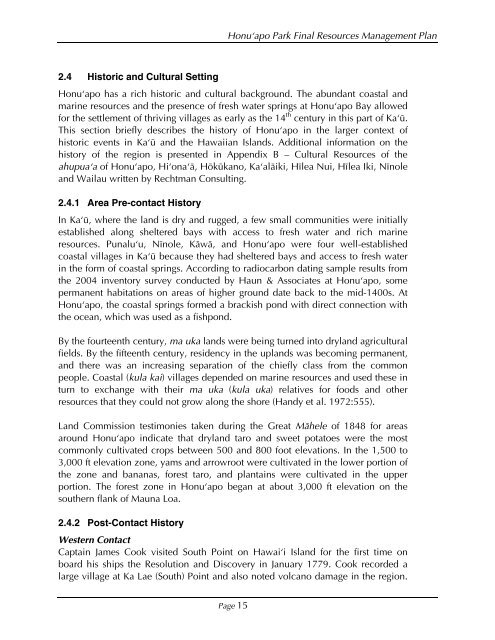Honu'apo Park Resource Management Plan
Honu'apo Park Resource Management Plan
Honu'apo Park Resource Management Plan
You also want an ePaper? Increase the reach of your titles
YUMPU automatically turns print PDFs into web optimized ePapers that Google loves.
2.4 Historic and Cultural Setting<br />
Honuÿapo <strong>Park</strong> Final <strong>Resource</strong>s <strong>Management</strong> <strong>Plan</strong><br />
Honuÿapo has a rich historic and cultural background. The abundant coastal and<br />
marine resources and the presence of fresh water springs at Honuÿapo Bay allowed<br />
for the settlement of thriving villages as early as the 14 th century in this part of Kaÿü.<br />
This section briefly describes the history of Honuÿapo in the larger context of<br />
historic events in Kaÿü and the Hawaiian Islands. Additional information on the<br />
history of the region is presented in Appendix B – Cultural <strong>Resource</strong>s of the<br />
ahupuaÿa of Honuÿapo, Hiÿonaÿä, Hökükano, Kaÿaläiki, Hïlea Nui, Hïlea Iki, Nïnole<br />
and Wailau written by Rechtman Consulting.<br />
2.4.1 Area Pre-contact History<br />
In Kaÿü, where the land is dry and rugged, a few small communities were initially<br />
established along sheltered bays with access to fresh water and rich marine<br />
resources. Punaluÿu, Nïnole, Käwä, and Honuÿapo were four well-established<br />
coastal villages in Kaÿü because they had sheltered bays and access to fresh water<br />
in the form of coastal springs. According to radiocarbon dating sample results from<br />
the 2004 inventory survey conducted by Haun & Associates at Honuÿapo, some<br />
permanent habitations on areas of higher ground date back to the mid-1400s. At<br />
Honuÿapo, the coastal springs formed a brackish pond with direct connection with<br />
the ocean, which was used as a fishpond.<br />
By the fourteenth century, ma uka lands were being turned into dryland agricultural<br />
fields. By the fifteenth century, residency in the uplands was becoming permanent,<br />
and there was an increasing separation of the chiefly class from the common<br />
people. Coastal (kula kai) villages depended on marine resources and used these in<br />
turn to exchange with their ma uka (kula uka) relatives for foods and other<br />
resources that they could not grow along the shore (Handy et al. 1972:555).<br />
Land Commission testimonies taken during the Great Mähele of 1848 for areas<br />
around Honuÿapo indicate that dryland taro and sweet potatoes were the most<br />
commonly cultivated crops between 500 and 800 foot elevations. In the 1,500 to<br />
3,000 ft elevation zone, yams and arrowroot were cultivated in the lower portion of<br />
the zone and bananas, forest taro, and plantains were cultivated in the upper<br />
portion. The forest zone in Honuÿapo began at about 3,000 ft elevation on the<br />
southern flank of Mauna Loa.<br />
2.4.2 Post-Contact History<br />
Western Contact<br />
Captain James Cook visited South Point on Hawaiÿi Island for the first time on<br />
board his ships the Resolution and Discovery in January 1779. Cook recorded a<br />
large village at Ka Lae (South) Point and also noted volcano damage in the region.<br />
Page 15


